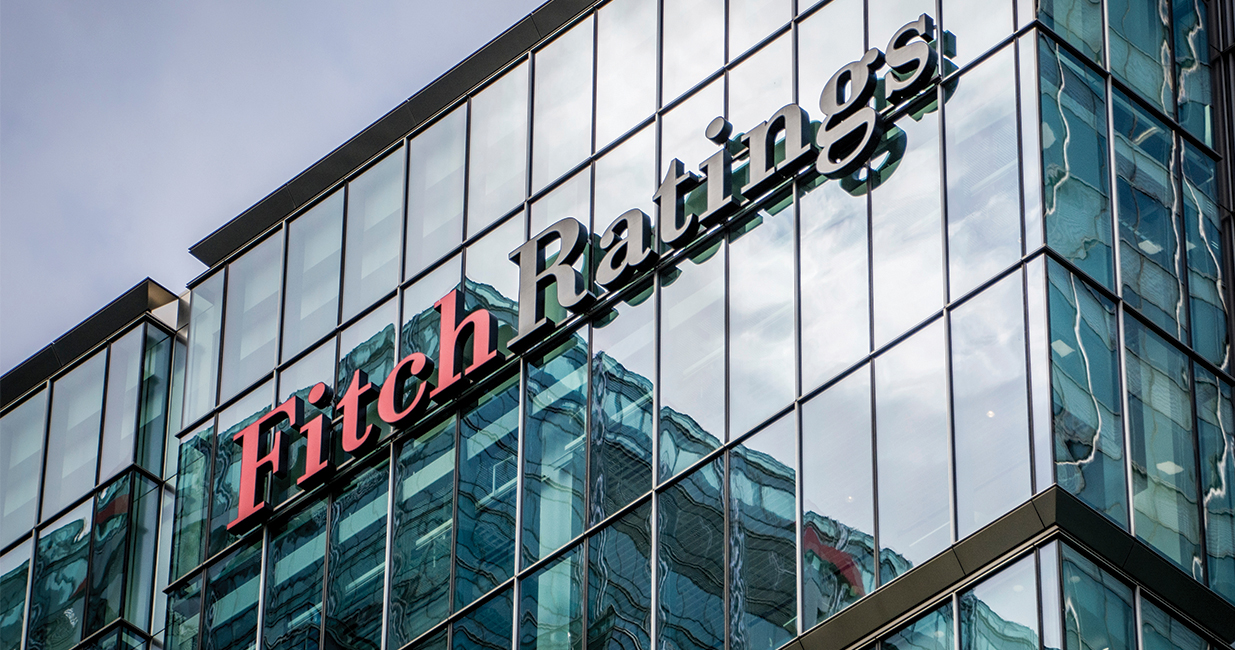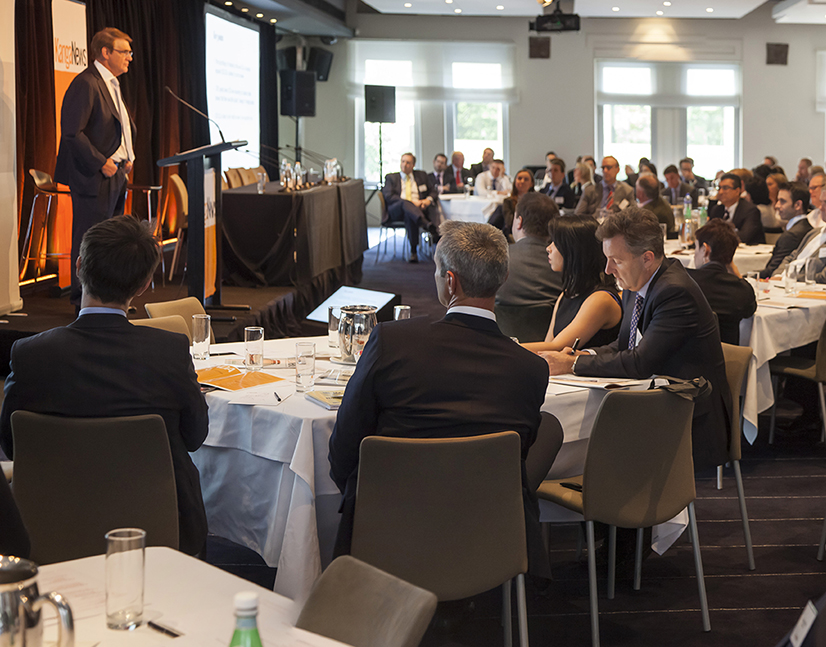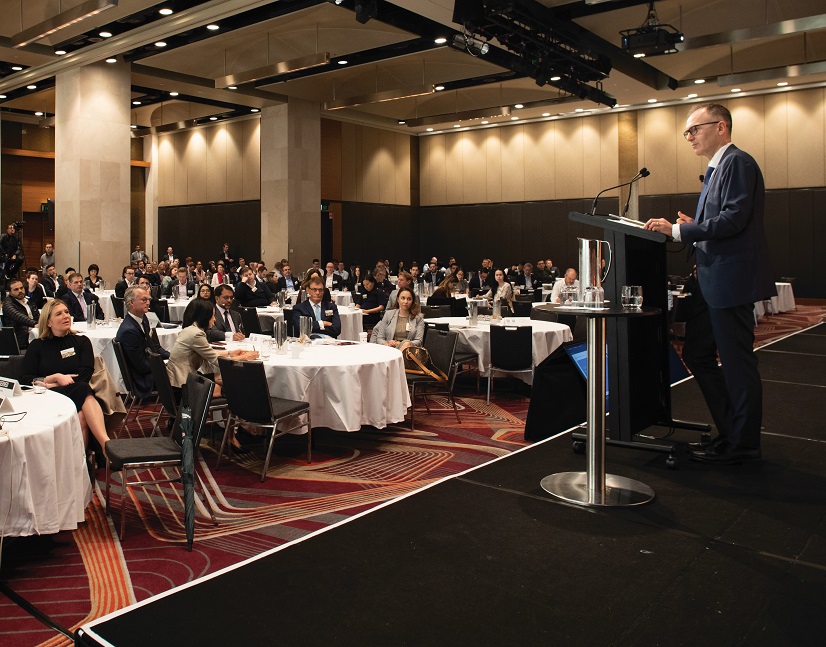
Australian corporate credit on the rebound
Investment-grade corporate Australia has weathered the COVID-19 crisis better than could have been expected as the pandemic accelerated in March and April 2020, according to participants at a Fitch Ratings-KangaNews roundtable at the end of the year. A supportive local debt market was just one of the factors behind this resilience.
PANDEMIC HITS
Davison Can each of the issuers describe how their business has been affected by COVID-19 and, in particular, how this performance has played out over the year, relative to base-case and worst-case scenarios they might have envisaged in March?
MACFARLANE Performance has not been as dire as we expected given the volatility and severity related to the impact of extended lockdowns on the business. The issue for us was we had a number of capital transactions in play at the start of the year, and when COVID-19 first hit those quickly fell away. We had made clear our intentions to divest some noncore businesses and we were very well progressed with discussions. But they dropped off as buyers were unable to find capital, or capital at the right price.
The board made the decision to withhold dividends and withdraw our earnings guidance. There was general uncertainty at the time, as was probably the case with all the borrowers at this discussion.
Our businesses are back up and running and we have had some wins on the sale of some of our noncore assets – there are signs of confidence in the market. This has helped us reposition our business and to have a more cautiously optimistic outlook for the year ahead.
VANDELIGT We had very resilient performance over the period. Operationally, the port was not affected at all – it is an essential service, which means there were no disruptions to operations as a result of the lockdown restrictions. Financial-year 2020 results were a little weaker than we had budgeted for prior to the pandemic but overall it was a solid performance given the environment.
Going into the disruption, we stress tested a range of scenarios and ultimately the business performed at the upper end of the spectrum of outcomes. This was driven in large part by our rental-revenue stream, which is not exposed to trade performance, as well the performance of import containers.
We experienced a softening in cargos such as motor vehicles and petroleum products, but the relatively good performance of import containers largely offset the decline in other cargo types and mitigated the decline at total trade level.
We suspect the reason import containers performed relatively well is that people who were able to retain their income found themselves sitting at home unable to spend on services. This meant many Melburnians began building up cash and actually increased their spending on goods for the home. The majority of these goods would have been imported from overseas via the port.
NOLAN Volume held up well under the circumstances for us, too. The various state and territory governments consider rail to be an essential service.
The containerised-freight side of the business benefited from restocking and also when restrictions eased. It slowed down after Easter and has then rebounded in the last few months, in which we are seeing volume 10 per cent higher than the prior year. While the early part of this rebound looked like it was due to restocking, we now see it as demand driven and the lead up to Christmas looks positive.
Elsewhere, our metallurgical- and thermal-coal volumes were affected more by customer production issues than by the pandemic itself – though we have seen some demand softness come through from India and China.
Our bulk activity, which is largely led by construction, is down significantly – but this was apparent before COVID-19 as well. The grain part of the business is very much weather dependent and we are gearing up for good volume across the next 12 months.
LI AGL Energy is also an essential business, which meant we felt the impact of COVID-19 to a lesser extent. We saw a drop in demand from our commercial and industrial customer bases but this was partially offset by more residential demand.
We have done a lot of scenario analysis on the effect of COVID-19 on our business and have created an additional support programme for affected customers, which has affected the bottom line.
But, overall, the worst-case scenario did not eventuate, especially as we came into the pandemic with ample liquidity: we reported more than A$1 billion (US$737.5 million) of undrawn cash at the end of our last financial year.
BRASSINGTON We have not been affected a whole lot. We were in production toward the end of March, at the very end of 2019/20 water delivery. We finished on 8 April, which gave us a six-week window before we had to think about starting up for 2020/21.
During this period, the operator brought in additional accommodation units and worked on ensuring segregation of work teams and getting everyone comfortable operating under these sorts of controls. We really haven’t had any issues since.
There were a couple of disruptions to our chemical supplies as most of our chemicals come from interstate, particularly from New South Wales (NSW). When the border between Victoria and NSW was closed for a very short period at the end of June, there was a small kerfuffle about truck drivers who were allowed to come into Victoria to deliver but were then told they had to quarantine for 14 days when they returned to NSW. However, this was sorted out in a couple of days.
From our point of view, most of the disruption has been the irritation and inconvenience of operating under restrictions. But compared with so many others it is hard to complain.
Pricing brought tears to my eyes relative to where margins were at the tail end of 2019. But having been through the financial crisis and other crises, I was not going to complain about a few basis points. My role is to ensure liquidity and mitigate refinancing risk.
Davison Lendlease has a global profile. How have Australian businesses performed relative to jurisdictions that have been less successful in managing the pandemic?
LARKIN There have been three main impacts on our business. There have been delays to activity, productivity impacts as we have had to implement social-distancing measures on our sites and, finally, valuation impacts on our investments.
We are, however, seeing activity coming back in residential and in retail. While we have seen some transactions delayed, we have still been able to bring capital partners into projects. We had a range of scenarios in March and we are in a better position than the more pessimistic cases. There is reason to be cautiously optimistic.
It is a diverse picture globally. Australia has been able to operate throughout the crisis. China has recovered the most quickly and had the fewest subsequent disruptions of any of our offshore markets. Elsewhere in Asia – meaning Singapore, Malaysia and Japan – the experience is broadly comparable to Australia.
Europe and the US have been the most challenged from a public-health perspective. Again, apart from brief shutdowns where we had to put new ways of working in place, we have generally been able to continue operating.
While there have been some significant impacts socially and in the economy in Europe and the US, it has not been as quite as bad for our operations as perhaps it has for other industries.
MACFARLANE We performed better than initially expected in New Zealand, given the level-four restrictions reduced our business operations by around 70 per cent. Initially we were unclear how long this would last, but it ended up being a short and sharp lockdown. New Zealand ended up recovering quite strongly and so did our business – no doubt helped by the government’s wage-subsidy scheme.
Similarly, most of our Australian businesses performed better than expected because of their reliance on government clients. “Urban services”, as we call this area, has a large proportion of local-, state- and federal-government customers. Their efficiency was reduced by social-distancing requirements, but things turned out better in the 2020 financial year than expected and these businesses have continued to improve since then.
Davison How have the sectors and individual issuers covered by rating analysts performed relative to expectations in 2020?
MELBOURNE Fitch took a portfolio approach to assessing the impact in March and triaged it from there. Right off the bat there were sectors we knew were going to be severely affected, such as tourism, air travel and autos. We took immediate rating actions against a lot of issuers in those sectors.
Following on from this, the group of issuers next in line was those that went into the pandemic with limited rating headroom. This was not necessarily sector-specific – it was companies that had balance sheets that were levered in March because of investment or M&A activity. Then the other bucket was all the other names.
Looking at Australia relative to all the Asian issuers I look after, Australian corporates performed relatively well. There were four rating actions in Australia in H1 2020 versus 18 or 19 in each of China, Indonesia and India.
There were second-order impacts, though. While construction continued, social-distancing measures slowed down a lot of projects and this had a knock-on effect. We saw a slowdown across the steel sector, for instance. Early on, our view was that it was going to be a V-shaped recovery but as the weeks passed it increasingly looked like a U-shaped recovery.
KISHORE At the outset of the pandemic we revised rating cases for demand-based assets in the infrastructure and project-finance space because they were the most affected. We set rating cases in March to be broadly aligned with the international outlook the Fitch global economics team produced.
We also recognised that the downturn could be prolonged, so we produced stress-test reports for each demand-based asset and mapped its recovery profile. We looked at a recovery all the way out to the end of 2024, largely to provide a worst-case scenario to investors and to provide a view of how ratings would be affected under these scenarios.
Since then, airports have tended to perform below our expectations globally because lockdowns have been prolonged and there have been additional phases of the health crisis in some countries. But we have seen a fairly strong recovery in markets where there is a higher share of domestic air travel such as China and, to an extent, India.
Toll-road performance reflected domestic conditions and the economic measures taken by governments in their respective countries.
China, for instance, had a very short period of restrictions and traffic has rebounded strongly. In Australia, Transurban and its offshoots have had a mixed performance. The assets in Sydney have performed better than Melbourne, reflecting the extended lockdown in the latter. Broadly, we expect performance will be down for the calendar year.
Ports have outperformed compared with what we were expecting in March. This reflects the essential nature of their operations. Port volume in offshore markets benefited from shortage of critical goods in some countries – for example, Indonesia needed to import medical supplies.
Power utilities have generally had stable performance and their ratings have held up. Energy demand has been muted in a lot of markets but it is picking up as economic activity resumes.
Governments are now trying to avoid going into a severe lockdown to avoid the economic impact, even during a second round of infections. We therefore see energy demand gradually picking up.
INVESTOR RESPONSE
Davison Australian credit investors as a group went long cash in the early stages of the crisis but there has been very strong support for new issuance throughout the second half. How did investors respond to the emerging pandemic and how has 2020 tracked relative to their expectations at that stage?
BAILLIE Spreads were quite tight at the start of the year and we would have described the market as reasonably late cycle. Then the pandemic reared its head and we saw extreme market moves in response to the lockdowns occurring overseas. Australian iTraxx, as a proxy, was trading at a historic low but in short order it was almost back to the decade-long wide level seen in the euro sovereign-debt crisis of 2011-12.
A few factors were behind this, including liquidity dynamics and the high correlation of Australian dollar spreads to equities and high-yield bonds. We also saw significant liquidity challenges in the risk-free markets including wide bid-offer spreads.
The market was cautious about asset-allocation rebalancing, currency revaluations and also the impact of early access to superannuation that could have seen flows out of credit and fixed income. Investors in general were trying to build up cash buffers to manage these risk factors.
The real catalyst for the peak in spreads came when the Fed [US Federal Reserve] announced its corporate bond-buying programme. This got investors out of the blocks and spreads began to retrace accompanied by an improvement in trading dynamics. Not long after this, the RBA [Reserve Bank of Australia] announced its term-funding facility (TFF), which was also very supportive of market-making from a technical perspective.
The combination of fiscal and monetary policy was key to investors gaining confidence to take advantage of wide spreads based on realistic expectations of global default rates and rating transition for investment-grade credits.
YUAN When the outbreak was starting in China in January, we began scenario planning for what could potentially happen and we reduced risk exposure from that point.
We were trying to reduce risk in two stages. The first was exposures related to China and the second was exposures that would be affected by a global outbreak. We got through most of the China-related credits but by the time we tried to reduce risk globally the March sell-off came – and very quickly. Liquidity completely dried up.
When regulators and central banks around the world put a floor beneath things and markets started to buy risk assets, we also started buying risk assets in select credits.
However, we were cautious following the rally in April because markets began to run hard in some sectors. We tried to keep price discipline even if it meant missing out on deals. Markets have been a lot stronger than most participants have anticipated.
LIQUIDITY CONSEQUENCES
Davison How did issuers find the availability of liquidity during the crisis, in particular compared with previous events like the financial crisis?
MACFARLANE The situation was completely different. In 2020, the issue was around price. At the height of the global financial crisis, it wasn’t just price – it was an absolute lack of liquidity.
We were able to complete a material refinancing of A$500 million in April, with strong support from our existing bank group. I understand there were challenges finding new money but our existing group was very supportive. Liquidity remained sound during the April-May period and it has rebounded further since then. So we have been able to successfully close a number of refinancings this year.
The pricing brought tears to my eyes relative to where margins were at the tail end of 2019. But having been through the financial crisis and other crises, I was not going to complain about a few basis points. My role is to ensure liquidity and mitigate refinancing risk.
VANDELIGT I agree. The port is in a strong liquidity position so we had no requirement to access funding during the peak of the disruption. But my sense was that it was readily available if it had been needed.
There was a week or so in March-April when liquidity generally was the tightest it had been since the financial crisis. On this basis, it would be wrong to say there was no stress in the market in early 2020.
LARKIN Liquidity has been much better in 2020. Monetary authorities moved quickly, decisively and innovatively compared with the financial crisis. It is astonishing to look back and think that Lehman Brothers was allowed to fail – it was a choice. We did not see any such thing this time around and I think this was a big part of the experience we have had over the last six months.
Funding has been available even if it is a question of at what price and with what terms and conditions. One of the main challenges in dealing with banks is around the volume of requests and the deal flow the major banks have been facing.
In April and May, we found the major banks were swamped and were prioritising clients they felt really needed support. Sometimes this made it difficult to get things done, not because lenders did not want to be supportive but because of the volume of requests coming through.
Taking it all together, though – and considering the scale of impact to economic activity – the way financial markets have handled it has been pretty amazing.
LI There was divergence of pricing between domestic and international banks. Prior to COVID-19, we saw comparable pricing between the two but this quickly reversed in April and May when we were looking to refinance a facility. It also seemed to be the case that banks restricted lending to new names. There was a lot of support for existing clients but lenders seemed to concentrate it on those that really needed the help. They would ask questions about whether we really needed the liquidity, and whether it would be revolving credit or a liquidity buffer.
We don’t do much project financing – it is more “general corporate purposes” – so there were a lot of questions about how we planned to use liquidity and whether we wanted it for buffer purposes.
MACFARLANE I agree. In recent years we have seen convergence on price for a typical 3-5-year bank loan, by which I mean all the lenders come in within a 5-10 basis point range.
My experience on pricing for larger deals in 2020 was that there was a significant gap between the international and domestic banks, and also between domestic banks depending on how their balance sheet was structured and what sort of pressure they were feeling from their residential and middle-market customers. This has definitely settled since June but it was a feature earlier in the year.
Supply dynamics and credit-investor strategy
In the absence of senior supply from domestic banks, Australian credit investors have more capacity than ever for alternative supply. This should provide a supportive environment for corporate issuance – though the focus is likely to remain on high-quality issuers.
YUAN The TFF [term funding facility] makes things very difficult as bank yield has tightened aggressively. Some financial bonds are trading at levels similar to semi-government and other higher-rated issuers.
The net result is lower yield across the board. But there is not much investors can do in an investment-grade credit mandate completely to offset lower yield. The support to date for long-dated corporate deals seems to be a product of low yield and limited supply of quality issuers.
OUTLOOK FOR 2021
Davison To what extent, if at all, have vaccine announcements sparked a change in outlook for corporate credit? In particular, how different will the outlook be if we are talking about a genuine return to the ‘old normal’ in 2021 as opposed to the type of mitigated reopening of the economy, including ongoing social-distancing restrictions, that might otherwise have been expected?
KISHORE The production of vaccines is yet to start and we don’t know what sort of timeframe it will take for them to be commercially available in sufficient quantity for most of the world. Vaccines are still some way from having a meaningful impact on the behaviour and shape of the recovery, in other words.
There is a lot of discussion about the destructive nature of the pandemic in changing consumer preferences including a more permanent shift to working from home. This may mean a reversal of the trend of millennials moving closer to city centres, too. We are yet to see if this will lead to a long-term shift in behaviour patterns but we believe there will be greater flexibility for employees to work from home in future.
These longer-term structural shifts could have some impact on the performance of toll roads and air travel. Having said this, we have seen evidence that not everything works as well in the virtual world. Education is a good example. There is still a strong preference to be back in schools, colleges and universities.
MELBOURNE We have not adjusted our forecasts because of vaccines. However, as a rating agency we are constantly reviewing our forecasts and our assumptions – and in fact they are changing more frequently than before.
The pandemic has effectively brought trends in some sectors forward. A lot of retail companies, for instance, were already under pressure but the impact of the pandemic has led to them closing.
This has flow on effects for REITs, and it leaves a question about what these companies are going to do with vacant spaces. Some are quite forward-thinking, had seen these trends coming and have adjusted their business models.
The other space is commercial. A number of the banks and large financial institutions are now hot desking – because office space is a significant component of their operating costs. People have been working more at home than in the office so any concerns about productivity have largely been put to bed.
“Prior to COVID-19, we saw comparable pricing between [domestic and international banks] but this quickly reversed in April and May when we were looking to refinance a facility. It also seemed to be the case that banks restricted lending to new names.”
Davison Are businesses planning for a fundamentally different future?
LARKIN There are a few potential themes but I think it may be too early to be definitive. Our development pipeline has a lot of mixed-use projects and we have the ability to repoint or respond accordingly. But yes, we think there will be behavioural changes.
The two sectors everyone seems to be keen on at the moment are ‘beds and sheds’, meaning residential and industrial. Of particular interest to us is build-to-rent and affordable housing. We have a significant presence in both these asset classes offshore and we are seeing interest in Australia.
It is too early to tell how all the factors will influence office space. We think there will be more focus on flexibility, and there are clear signs that employees like the flexibility working from home offers. But it depends on how this plays out against the need for more space per employee and maybe a move away from ‘agile’ workplaces.
We are still hearing that capital partners are interested in putting money into commercial and office. It will continue to be an important sector.
One way of looking at COVID-19 for bricks-and-mortar retail is that it will accelerate the trend toward experience – major centres as hubs rather than just shopping. Across our business and in some of our funds, we think this creates potential for mixed-use opportunities. Again, we are expecting change but markets, industries and corporates do not always turn on a dime so the shape of the future might take a while to figure out.
I’d also like to add a point about vaccines. I agree that vaccines may take some time to be manufactured and available, and I agree that they are not going to produce a return to normal quickly.
But the most important positive thing about vaccines is that they reduce the tail risk of extended shutdowns and the stop-start threat to the economy. This will provide confidence for investment decisions and activity levels should respond as a result. Even if vaccines take time to roll out, which is a reasonable assumption, it is still a significant step toward closing off a lot of the downside of a world without a vaccine.
BRASSINGTON In the US, the subject of vaccines is a highly politicised issue. I think I saw a statistic that 40 per cent of the US population would not take a vaccine if it was offered to them. That is clearly going to be an issue faced by a lot of countries.
The other point is that about 150 countries simply cannot afford to vaccinate their population. The vaccines might be great but they could be a while off, worldwide.
Once they are readily available in first-world economies we shouldn’t see a repeat of the knee-jerk reaction we saw in South Australia this week. If that kind of response is possible over the next couple of years, it would be enormously challenging for everybody.
ESG SPECIFICS
Davison How would participants sum up the evolution of the sustainable debt market in 2020? Let’s start with the global market, where there has been development in structure as well as in the sources of new issuance.
TANG Across the world, green-bond issuance dropped off in 2020. The growth was from social bonds, of which a big chunk was pandemic bonds and 90 per cent were in China. It was a very specific type of issuance.
We heard mixed views from investors on their willingness to accept pandemic bonds. A lot of them were loosely tied to COVID-19 relief programmes and there were also issues with tenor. Some of the bonds would be for 10 years whereas the proceeds were going to programmes that were only a few years in length – and there was not much clarity about the use of proceeds afterwards.
One of the more positive developments in 2020 has been the push by sovereign issuers, including in SDG [UN Sustainable Development Goals] and social format, such as from Mexico and Ecuador. The importance of sovereign issuance is that it sets a benchmark for the market.
There have been a lot of questions around the liquidity of green bonds and here the German sovereign green bond was particularly interesting. Germany has committed to issuing matched bonds – for every vanilla bond there is a matched green bond with the same coupon and maturity, creating a pricing anchor. This can help with liquidity issues and it makes it easier to capture the green premium.
Germany has committed to building out a whole green curve and a number of European countries are following suit. This government push and some of the green-linked packages we have seen, such as in the EU and certain parts of Asia, have provided a supply boost.
Davison In Australia, it looked like sustainable debt had been sidelined by more pressing concerns for much of the first three quarters of the year, but it now seems the market has regained its momentum. Is engagement still growing and what are the main developments?
TANG We went from A$7.5 billion of issuance in 2019 to A$150 million in first half of 2020. But we now have a rush of transactions including from New South Wales Treasury Corporation, Lendlease and Brighte. We expect this to continue in 2021 even though there is not the same national-government push as in other jurisdictions.
We are seeing further development in sustainability-linked loans (SLLs), sustainability-linked bonds (SLBs) and other variations. Australia was one of the leaders in SLL adoptions and now we are starting to see SLBs pop up around the world, including from Enel, Chanel, Suzano and Novartis.
A lot of SLBs were initially focused on reaching emissions targets but are now broadening. For example, Novartis’s bond links to metrics related to its healthcare programmes. We expect this type of bond issuance to increase in various locations. Whether these include Australia is another question. I would be interested to hear what the issuers have to say about SLBs as a concept.
“Longer-term structural shifts could have some impact on the performance of toll roads and air travel. Having said this, we have seen evidence that not everything works as well in the virtual world. Education is a good example. There is still a strong preference to be back in schools, colleges and universities.”
MACFARLANE The SLL format made sense to us given the way our balance sheet is funded. We did not have specific assets to which to apply green-bond proceeds, which have to be ringfenced for a particular asset. The general portfolio approach of an SLL was far more relevant for the group.
We have always had a strong ESG [environmental, social and governance] strategy. We publish an annual sustainability report that focuses on things like emissions, diversity, training and governance.
The issue for us was that we had not aligned this ESG strategy with our financing strategy. The SLL provided the ideal opportunity to bring the two together.
Importantly for us, we had a head start given the maturity of our ESG function. But there was still quite a lot of work to be done landing on the suite of KPIs and targets, and we worked closely with our bank group to develop something that would resonate strongly in the market and within the company itself.
The final structure combines environmental and social KPI metrics relating to Downer’s greenhouse-gas emissions reductions and social sustainability – being cultural awareness, and the mental health and wellbeing training of Downer employees.
These social KPIs were already well developed within Downer but their inclusion in the SLL provides an additional level of stretch or ambition over the life of the facility.
We have more than 50,000 employees across the group, so these KPIs are very relevant to our employees and tools like the SLL will hopefully provide further momentum internally.
LARKIN Echoing some of these themes, we announced new sustainability targets for the group prior to launching our green bond. Lendlease had been doing some work on refreshing its sustainability strategy for some time.
The issue for us had never been a lack of assets or projects that could be eligible but how we tie the financing and sustainability strategies together. There was momentum on both internally and from there it was a question of what role treasury could play to support this.
Work was needed to prepare to go to market, including putting together a framework and getting it assured. But our view is that the effort to take a green bond to market was well and truly worth it. Offering the deal in green format enabled us to have a different kind of conversation with investors and focus on a key strength of Lendlease’s.
We had a similar experience to Downer in that the internal interest in this transaction has been unlike anything I have ever done at Lendlease. We’re a fairly regular borrower for Lendlease itself as well as for our managed projects and funds, but the internal reaction to the green bond has been night and day when it comes to capturing engagement within the organisation. The interest and engagement will no doubt help deliver on some of the business’s objectives.
We are very happy with the outcome. Given the nature of our business, it is not difficult to imagine a significant amount of our funding in the future will be green in some shape or form, in line with the business strategy.
Davison Would investors support an SLB with or without two-way pricing?
YUAN The detail of the pricing would be key. A vanilla bond pays a particular return and – assuming the issuer has an ESG plan, publishes ESG reports and has regular discussions with us – we know what the return is and what the ESG risks are. It is a known quantity.
With an SLB, if the best-case scenario for the issuer and the lowest-return case for us is a yield lower than the plain vanilla bond, why would investors buy it instead of a responsible ESG issuer? On the other hand, it would also be a poor outcome if the issuer of the SLB was not punished sufficiently for breaching its ESG promises.
Davison Is it appropriate for investors to benefit financially from poor ESG performance by an SLB issuer?
YUAN We would be benefiting financially but would have to explain poor ESG performance to clients. They would ask why we are investing in such a poor ESG performer. In a way, we don’t want to be paid for that sort of behaviour.
The big picture is that ESG is rapidly becoming mainstream. Fitch and other credit rating agencies and data providers have embedded ESG into normal analysis. Most of our end investors are now asking for ESG analysis, reporting, filters and feedback on new mandates. We are more worried about poor ESG performers than we are looking to benefit financially from them.
BAILLIE I agree. The question we have to ask is what the ultimate destination for SLBs may be. The complexities of SLBs are not necessary for us to achieve our objectives, and the other thing to keep in mind is that market dynamics could overwhelm the benefit or the penalty in these structures.
I struggle to get my head around this, because where we are in the credit cycle can change how we view the benefit or penalty. What is the right quantum of step-up or step-down if spreads have blown out 50 or 100 basis points when the penalty or benefit is only 10 basis points? Does it really affect the overall cost of capital and issuer or investor behaviour?
For me, the focus still needs to be on the appropriate engagement model for investors and issuers to see the transition to more sustainable business practices, models and frameworks. The use-of-proceeds method seems, at this point, to be the most effective way to encourage and change behaviour.
Another factor worth noting is that there has already been a ‘greenium’ in some of 2020’s new issuance. It appears to us that there is a 20-25 basis points discount for triple-B-band issuers with greater exposure to thermal coal given concerns around supply-demand dynamics and refinancing risk, particularly around longer-dated paper.
This will become a distinguishing factor as analysts are already incorporating ESG into their ratings and risk assessments more than ever. We have seen an explosion of consultants and clients wanting to understand our ESG philosophy and process. It certainly accelerated after the bushfires at the start of 2020 and while this eased with COVID-19 the wave is pretty powerful.
An evolving take on the domestic market
The domestic bond market has supported local corporate issuers with impressive volume and duration for most of 2020, notwithstanding pandemic-related volatility. Most – but not all – borrowers are confident there has been a genuine step-change in capacity and consistency dynamics.
LARKIN Undoubtedly, yes. The key to this is your perspective. Looking back over five years or more, we are in a vastly different world. The local market is more sophisticated, there are more investors, it is deeper, and it is more active in looking down the credit curve and at longer tenor.
Of course there will always be ups and downs. But I think there is a very clear trend that sees the Australian market continue along this trajectory. Often over the last several years it has comfortably been a better choice on value as well. It is never going to be as deep as Europe or the US, but it has matured enormously.

Lendlease came to the domestic market in 2013 and the transaction process was a bit like a club deal rather than putting together a distributed bond offering. By contrast, the process we went through most recently for our green bond operated and felt just like all the other international bond markets.
Davison What role does ESG funding play for more ‘coal-adjacent’ credits like AGL and Pacific National? AGL has a clear transition plan but is Pacific National’s future indelibly linked to coal?
LI We completed an SLL last year and we are certainly interested in pursuing further issuance and structures in this space. The challenge for us is to understand investor appetite given we are a carbon-intensive company – we are Australia’s largest emitter.
Most green and dark-green investors would simply screen us out because of the nature of our business. If we were committed to showing a structure where financing cost is linked to sustainability KPIs, I would be interested to understand investor feedback and demand on such a debt instrument. The two bespoke KPIs we had in our SLL were carbon-emission intensity and percentage of renewable generation.
It is a long journey to transition and unfortunately we cannot just exit coal overnight. We have to ensure we can provide reliable and affordable energy, and transition responsibly. We have to bring investors along with us on this journey. It is a question of whether a structure would encourage investors to come with us.
We cannot, unfortunately, commit to an emissions-based target because there are so many uncertainties in the regulatory space and many factors could move the dial.
To what extent it would be considered ambitious by investors, what mechanisms there are, whether it is a targeted approach, and whether it is like our SLL – where we had year-on-year improvements – are all questions we don’t have answers for. But we are certainly keen to explore the options.
NOLAN We have a very interesting business with two strong parts – freight and coal. We are focused on the containerised-freight component of our business and believe it has huge growth potential in future, particularly getting containers off road and onto rail.
There are massive ESG benefits to this. Rail produces 16 times less emissions than road freight per tonne kilometre, for instance, while road-freight crash costs are 14 times higher than rail freight per tonne kilometre. These are huge statistics and put a compelling story for rail freight.
Touching on our coal business, yes, we move both metallurgical and thermal coal. There is no substitute for metallurgical coal in the production of steel and we see this as a sustainable product for us going forward.
Australia produces the world’s best thermal coal. It has the highest energy content and – given the growth of coal-fired power station capacity globally, particularly in Asia – the industry has many years to run. The world would also be better off consuming high-quality Australian thermal coal at the expense of Indonesian and Chinese coal, so it can work toward a more sustainable position in the future.
We talk to investors about ESG often. We are in the final stages of our first ever ESG report and a lot of these messages will come out in it.
LARKIN We have given some thought to the idea of issuing an SLB. However, the views we have heard from investors today are consistent with what we have heard in other discussions. As a product, it does not feel like something that has a lot of interest.
As an issuer, one-way pricing also does not really make a whole lot of sense. If we are going to try to use a price signal to spur behaviour it needs to be two-way, but this is not the way the market works. It is perhaps why we are seeing a more vibrant SLL market. But it is a new product and maybe the market will evolve.
“We heard mixed views from investors on their willingness to accept pandemic bonds. A lot of them were loosely tied to COVID-19 relief programmes and there were also issues with tenor. Some of the bonds would be for 10 years whereas the proceeds were going to programmes that were only a few years in length.”
Davison Could SLBs turn into a white elephant given analysts will increasingly look to take into account, and price, ESG risks without the need for sustainability performance to appear in debt terms and conditions? Do we need labelled debt instruments at all, in other words?
TANG ESG is an umbrella term for a lot of things and, similarly, it is a term for investors trying to achieve different remits. Some might be trying to incentivise a particular issuer to undertake an action and be willing to pay a premium for it, and then there is purely assessing how ESG issues around climate and emissions regulation actually affect credit risk.
We integrate ESG issues into our credit assessments – and in a more and more detailed way, including coordinated views on how global climate regulation is tracking and what is happening with carbon pricing.
Issuer considerations are the core premise of sustainability-linked instruments, which were partly born from concern about use-of-proceeds-based green bonds if issuers’ activities are not all sustainability-aligned. Some investors wanted an instrument that tied to an issuer’s activities, not just the use of proceeds.

WOMEN IN CAPITAL MARKETS Yearbook 2023
KangaNews's annual yearbook amplifying female voices in the Australian capital market.

















